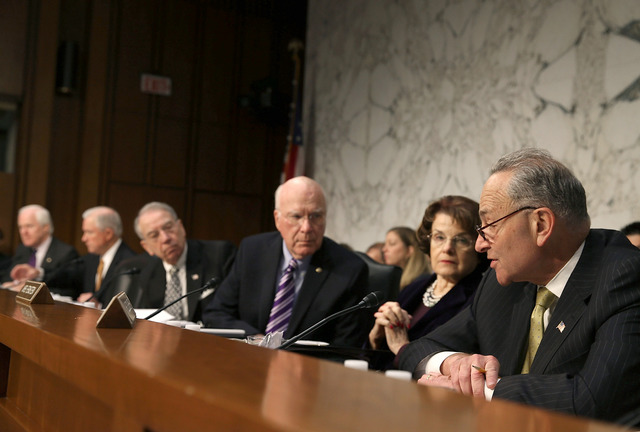By Bryson Culver
Following the death of Justice Antonin Scalia this month, a whirlwind of controversy has converged upon the appointment of a new Supreme Court Justice. Already, conflict has arisen between the White House and the Senate. In a recent statement, Senate Majority Leader Mitch McConnell (R-KY) announced that “The American people should have a voice in the selection of their next Supreme Court Justice. Therefore, this vacancy should not be filled until we have a new president” while the Obama administration ensured that “We expect the Senate to consider the nominee, consistent with their responsibilities laid out in the United States Constitution.”
In the coming weeks, we will likely see similar action regarding the Supreme Court nomination. While installing a liberal justice might be beneficial for President Obama’s policy goals, he does not have the luxury earlier presidents had in selection. The politicization of the confirmation process has forced the Obama administration to, at the very least, acknowledge the demands of the Senate. Whether Obama will find compromise in a moderate candidate or push hard for a more liberal option is yet unknown.
Ironically, the ensuing political turmoil generated by Scalia’s death goes against the very principles Scalia held. Congruent with the first 200 years of judicial appointment processes, Scalia insisted on the apolitical in judicial appointments, free from the political pressures rampant in Congress and the Presidency. Why then, with such a longstanding tradition of judicial non-partisanship, are we tossed into a raging political battle for the new appointment?
The answer lies in the past fifty years, when the appointment of judges to federal courts has become a highly politicized and policy-driven activity. Beginning with the Nixon administration, Presidents have become increasingly inclined to appoint justices in order to further their policy goals. By installing judges who share an administration’s policy preferences, the influence of these preferences remain significant far beyond the life of the administration that spurred them. , the appointment procedures and processes that aim to find the best candidates to fulfill this objective.
The changing political dynamics of the appointment process are shown in the actions of the judiciary. Research has shown that the conservative and liberal voting patterns of judges often follow the political party of the President that appointed them. By implementing administrative screening to appoint judges that share the policy goals of the President, the ideological makeup of the Supreme and Appellate courts have shifted with each successive President. The observed result is an extension of a president’s policy agenda beyond the 4 to 8 years of his elected office, extending to the 15 to 20 more years of a judge’s life tenure.
These actions have led the judiciary to become less and less independent. Instead, judges have become tied to the policy goals of the previous decade’s presidential administrations. The effect of this newfound influence is not blatantly apparent and, in fact, mostly goes unnoticed; however, from time to time, the influence of politically-motivated appointments does rear its ugly head. In cases heavily invested in party politics, justices almost always vote along party lines according to their appointing President. The most transparent example of this trend is the 2000 case Bush v. Gore, in which the Supreme Court rejected a recount of Florida votes giving Bush the final electoral votes he needed to become President. In this instance, each justice voted in favor of the party of their appointing Presidents. Most legal experts criticize the actions of this court as majorly, if not entirely, politically motivated. The actions of the court partly reflected the political loyalties the justices’ retained from their appointing Presidents.
“From time to time, the influence of politically-motivated appointments to the court rears its ugly head”
The ability of a Presidential administration to unilaterally advance their policy ambitions in the courts eventually wavered. The Nixon, Carter, and Reagan administrations enjoyed little opposition to their policy-based appointments, but the later Clinton and Bush administrations were forced to face Congressional reaction to partisan appointments. In the appointment process, the “Advice and Consent” of the Senate has historically been a formality. Before 1977, the confirmation rate was almost 100% with few failed appointments based on blatant acts of racism, illegal activity, or sexism; however, following a Senatorial reaction to the Presidents’ politically motivated nominations, the actions of the opposition party reduced the confirmation rate to 65% under Clinton and almost 50% under Bush. Additionally, the confirmation with some nominations taking three years to be confirmed. These pressures, combined with severe vacancy issues in the courts, forced the later Presidents to find more moderate, confirmable candidates.
Learning from his predecessors, President Obama has had better foresight in selecting judges who both sides of the aisle find palatable. Though the Democrats maintained control of the Senate for three-fourths of his presidency, certain procedural holds were used by many Republican senators (for instance, the ability of home-state senators to block appointments from states they represent). Obama circumvented these holds by focusing on moderate, passable appointees. Unlike Clinton and Bush, Obama has had greater success in procuring relative bi-partisan support for many of his more moderate appointees. However, whether he will find this success in replacing Scalia despite the newfound obstinacy of the Senate is yet to be seen.
